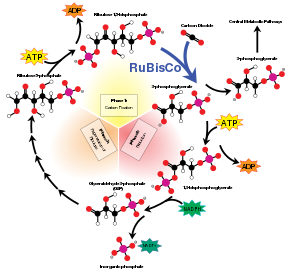C3 carbon fixation

C3 carbon fixation is the most common of three metabolic pathways for carbon fixation in photosynthesis, along with C4 and CAM. This process converts carbon dioxide and ribulose bisphosphate (RuBP, a 5-carbon sugar) into two molecules of 3-phosphoglycerate through the following reaction:
- CO2 + H2O + RuBP → (2) 3-phosphoglycerate
This reaction occurs in all plants as the first step of the Calvin–Benson cycle. (In C4 and CAM plants, carbon dioxide is drawn out of malate and into this reaction rather than directly from the air.)

Plants that survive solely on C3 fixation (C3 plants) tend to thrive in areas where sunlight intensity is moderate, temperatures are moderate, carbon dioxide concentrations are around 200 ppm or higher,[1] and groundwater is plentiful. The C3 plants, originating during Mesozoic and Paleozoic eras, predate the C4 plants and still represent approximately 95% of Earth's plant biomass, including important food crops such as rice, wheat, soybeans and barley.
C3 plants cannot grow in very hot areas because RuBisCO incorporates more oxygen into RuBP as temperatures increase. This leads to photorespiration (also known as the oxidative photosynthetic carbon cycle, or C2 photosynthesis), which leads to a net loss of carbon and nitrogen from the plant and can therefore limit growth.
C3 plants lose up to 97% of the water taken up through their roots to transpiration.[2] In dry areas, C3 plants shut their stomata to reduce water loss, but this stops CO2 from entering the leaves and therefore reduces the concentration of CO2 in the leaves. This lowers the CO2:O2 ratio and therefore also increases photorespiration. C4 and CAM plants have adaptations that allow them to survive in hot and dry areas, and they can therefore out-compete C3 plants in these areas.
The isotopic signature of C3 plants shows higher degree of 13C depletion than the C4 plants, due to variation in fractionation of carbon isotopes in oxygenic photosynthesis across plant types.
Scientists have designed new metabolism pathways which reduces the losses to photorespiration, by more efficiently metabolizing the toxic glycolate produced. This resulted in over 40% increase in biomass production in their model organism (the tobacco plant) in their test conditions. The scientists are optimistic that this optimization can also be implemented in other C3 crops like wheat.[3]
References
- ^ C. Michael Hogan. 2011. "Respiration". Encyclopedia of Earth. Eds. Mark McGinley and C. J. Cleveland. National Council for Science and the Environment. Washington, D.C.
- ^ Raven, J. A.; Edwards, D. (March 2001). "Roots: evolutionary origins and biogeochemical significance". Journal of Experimental Botany. 52 (Supplement 1): 381–401. doi:10.1093/jexbot/52.suppl_1.381. PMID 11326045.
- ^ South, Paul F.; Cavanagh, Amanda P.; Liu, Helen W.; Ort, Donald R. (2019). "Synthetic glycolate metabolism pathways stimulate crop growth and productivity in the field". Science. 363 (6422): eaat9077. doi:10.1126/science.aat9077. PMID 30606819.
